CIPD 7CO02: People Management & Development Strategies for Performance
VerifiedAdded on 2023/06/13
|56
|23296
|137
Report
AI Summary
This report provides a comprehensive analysis of people management and development strategies, addressing sixteen key questions within the context of CIPD 7CO02. It covers various aspects of human resource management, learning and development activities, HR models, high-performance work practices, and employment relationships. The report emphasizes the vital role of HRM in enhancing organizational performance and growth, focusing on areas such as employee motivation, engagement, vertical alignment of HR and L&D practices with business strategy. It also highlights the importance of employee motivation and engagement, utilizing models like the human relations model to foster strong connections and improve overall productivity. The report uses examples like Marks and Spencer to illustrate the practical application of vertically aligned HR practices. Desklib provides students access to this and many other solved assignments and past papers.
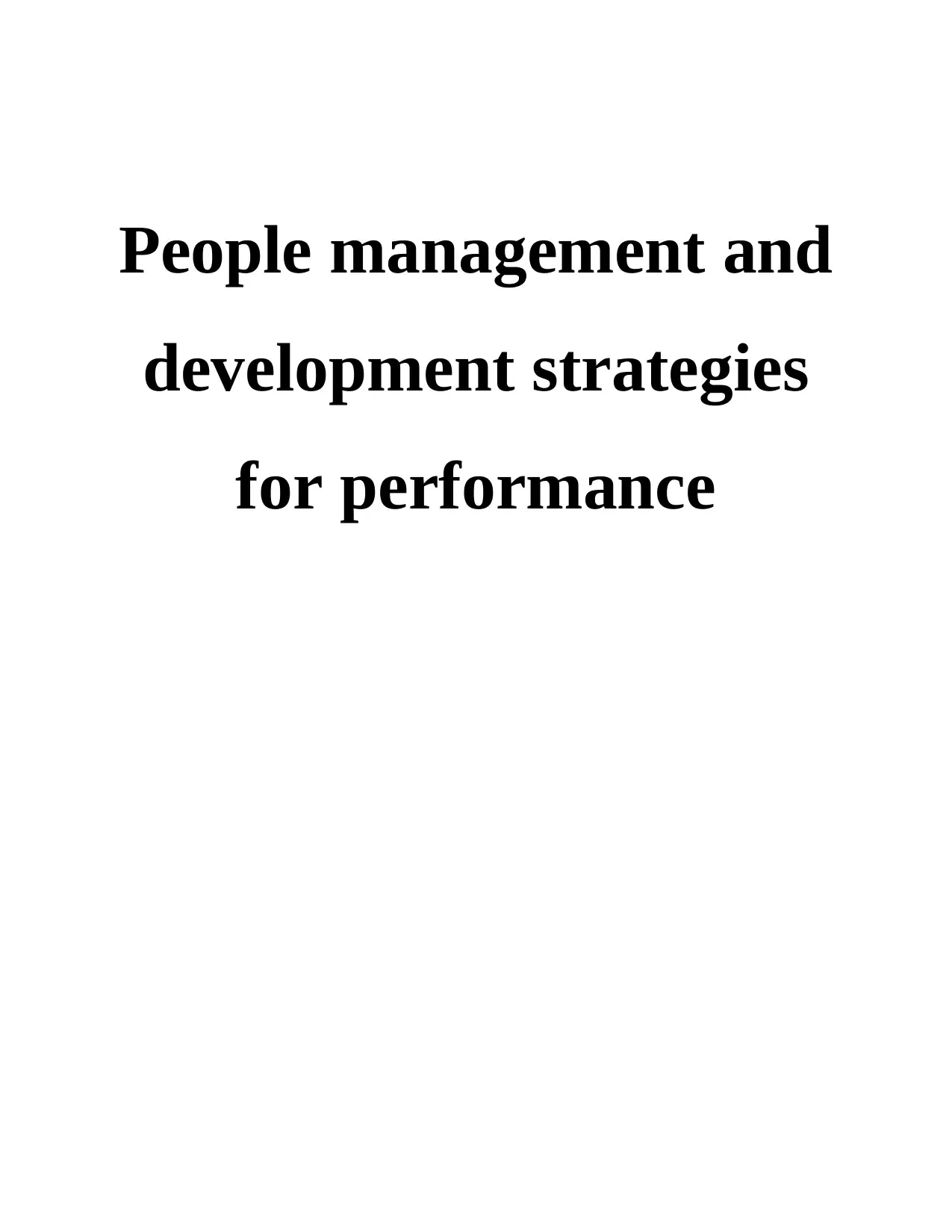
People management and
development strategies
for performance
development strategies
for performance
Paraphrase This Document
Need a fresh take? Get an instant paraphrase of this document with our AI Paraphraser
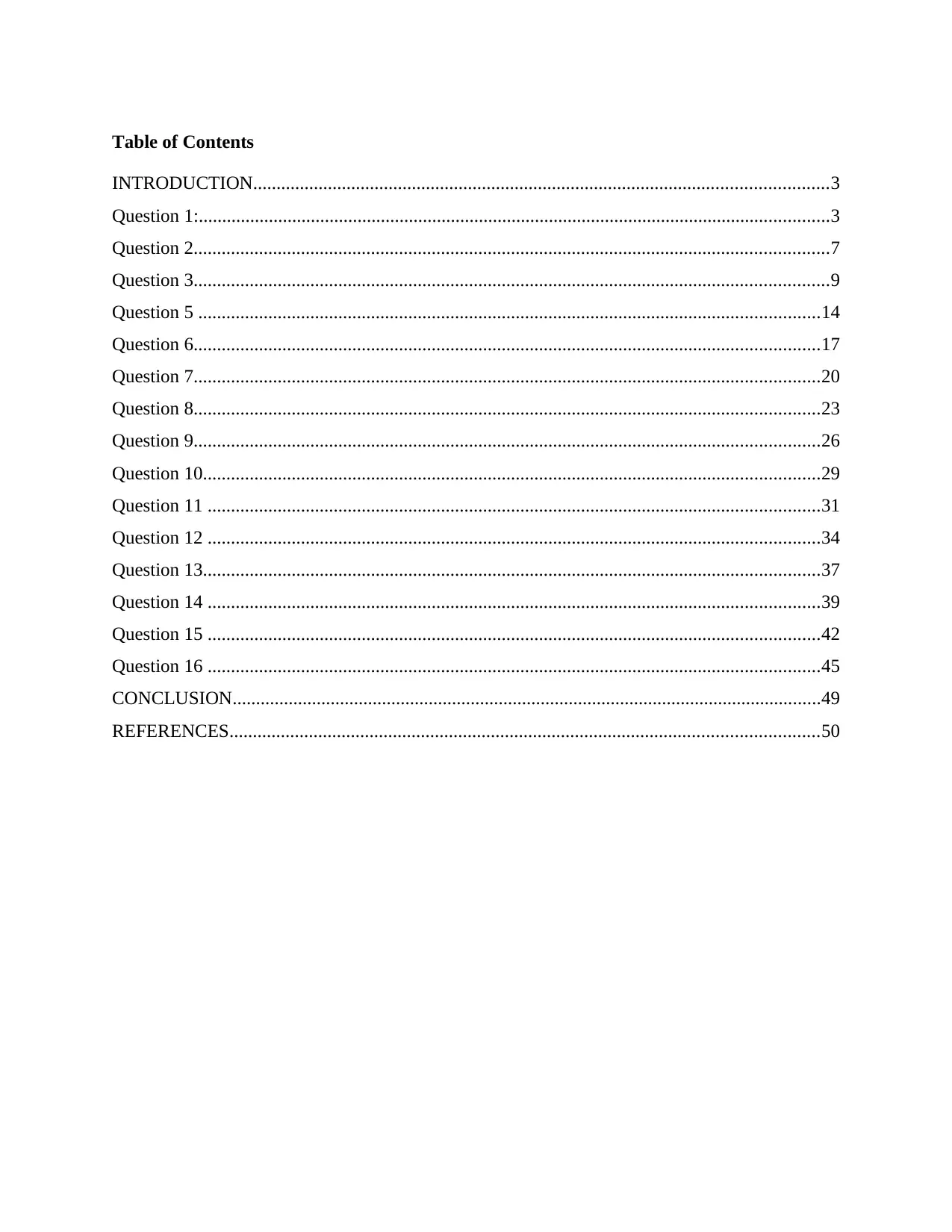
Table of Contents
INTRODUCTION...........................................................................................................................3
Question 1:.......................................................................................................................................3
Question 2........................................................................................................................................7
Question 3........................................................................................................................................9
Question 5 .....................................................................................................................................14
Question 6......................................................................................................................................17
Question 7......................................................................................................................................20
Question 8......................................................................................................................................23
Question 9......................................................................................................................................26
Question 10....................................................................................................................................29
Question 11 ...................................................................................................................................31
Question 12 ...................................................................................................................................34
Question 13....................................................................................................................................37
Question 14 ...................................................................................................................................39
Question 15 ...................................................................................................................................42
Question 16 ...................................................................................................................................45
CONCLUSION..............................................................................................................................49
REFERENCES..............................................................................................................................50
INTRODUCTION...........................................................................................................................3
Question 1:.......................................................................................................................................3
Question 2........................................................................................................................................7
Question 3........................................................................................................................................9
Question 5 .....................................................................................................................................14
Question 6......................................................................................................................................17
Question 7......................................................................................................................................20
Question 8......................................................................................................................................23
Question 9......................................................................................................................................26
Question 10....................................................................................................................................29
Question 11 ...................................................................................................................................31
Question 12 ...................................................................................................................................34
Question 13....................................................................................................................................37
Question 14 ...................................................................................................................................39
Question 15 ...................................................................................................................................42
Question 16 ...................................................................................................................................45
CONCLUSION..............................................................................................................................49
REFERENCES..............................................................................................................................50
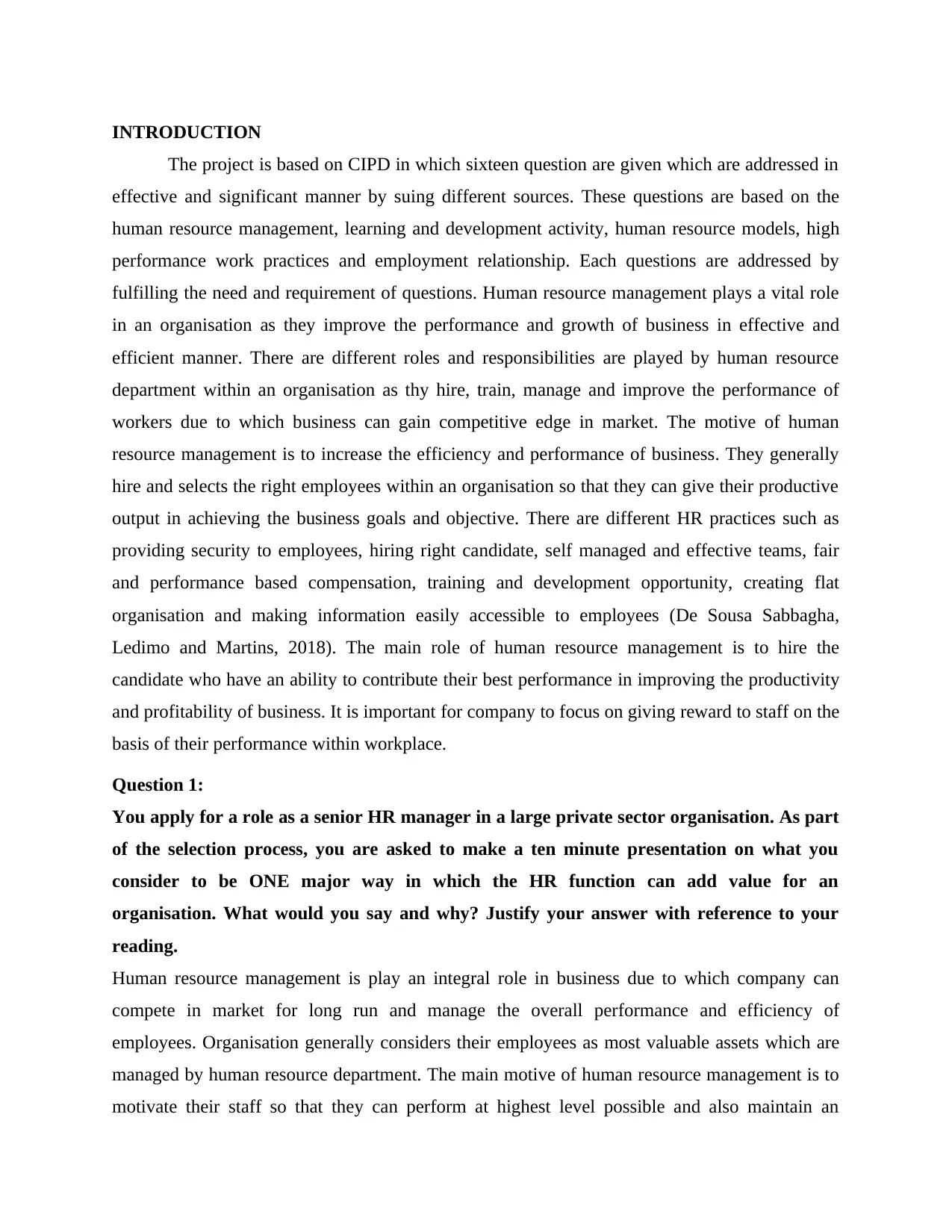
INTRODUCTION
The project is based on CIPD in which sixteen question are given which are addressed in
effective and significant manner by suing different sources. These questions are based on the
human resource management, learning and development activity, human resource models, high
performance work practices and employment relationship. Each questions are addressed by
fulfilling the need and requirement of questions. Human resource management plays a vital role
in an organisation as they improve the performance and growth of business in effective and
efficient manner. There are different roles and responsibilities are played by human resource
department within an organisation as thy hire, train, manage and improve the performance of
workers due to which business can gain competitive edge in market. The motive of human
resource management is to increase the efficiency and performance of business. They generally
hire and selects the right employees within an organisation so that they can give their productive
output in achieving the business goals and objective. There are different HR practices such as
providing security to employees, hiring right candidate, self managed and effective teams, fair
and performance based compensation, training and development opportunity, creating flat
organisation and making information easily accessible to employees (De Sousa Sabbagha,
Ledimo and Martins, 2018). The main role of human resource management is to hire the
candidate who have an ability to contribute their best performance in improving the productivity
and profitability of business. It is important for company to focus on giving reward to staff on the
basis of their performance within workplace.
Question 1:
You apply for a role as a senior HR manager in a large private sector organisation. As part
of the selection process, you are asked to make a ten minute presentation on what you
consider to be ONE major way in which the HR function can add value for an
organisation. What would you say and why? Justify your answer with reference to your
reading.
Human resource management is play an integral role in business due to which company can
compete in market for long run and manage the overall performance and efficiency of
employees. Organisation generally considers their employees as most valuable assets which are
managed by human resource department. The main motive of human resource management is to
motivate their staff so that they can perform at highest level possible and also maintain an
The project is based on CIPD in which sixteen question are given which are addressed in
effective and significant manner by suing different sources. These questions are based on the
human resource management, learning and development activity, human resource models, high
performance work practices and employment relationship. Each questions are addressed by
fulfilling the need and requirement of questions. Human resource management plays a vital role
in an organisation as they improve the performance and growth of business in effective and
efficient manner. There are different roles and responsibilities are played by human resource
department within an organisation as thy hire, train, manage and improve the performance of
workers due to which business can gain competitive edge in market. The motive of human
resource management is to increase the efficiency and performance of business. They generally
hire and selects the right employees within an organisation so that they can give their productive
output in achieving the business goals and objective. There are different HR practices such as
providing security to employees, hiring right candidate, self managed and effective teams, fair
and performance based compensation, training and development opportunity, creating flat
organisation and making information easily accessible to employees (De Sousa Sabbagha,
Ledimo and Martins, 2018). The main role of human resource management is to hire the
candidate who have an ability to contribute their best performance in improving the productivity
and profitability of business. It is important for company to focus on giving reward to staff on the
basis of their performance within workplace.
Question 1:
You apply for a role as a senior HR manager in a large private sector organisation. As part
of the selection process, you are asked to make a ten minute presentation on what you
consider to be ONE major way in which the HR function can add value for an
organisation. What would you say and why? Justify your answer with reference to your
reading.
Human resource management is play an integral role in business due to which company can
compete in market for long run and manage the overall performance and efficiency of
employees. Organisation generally considers their employees as most valuable assets which are
managed by human resource department. The main motive of human resource management is to
motivate their staff so that they can perform at highest level possible and also maintain an
⊘ This is a preview!⊘
Do you want full access?
Subscribe today to unlock all pages.

Trusted by 1+ million students worldwide
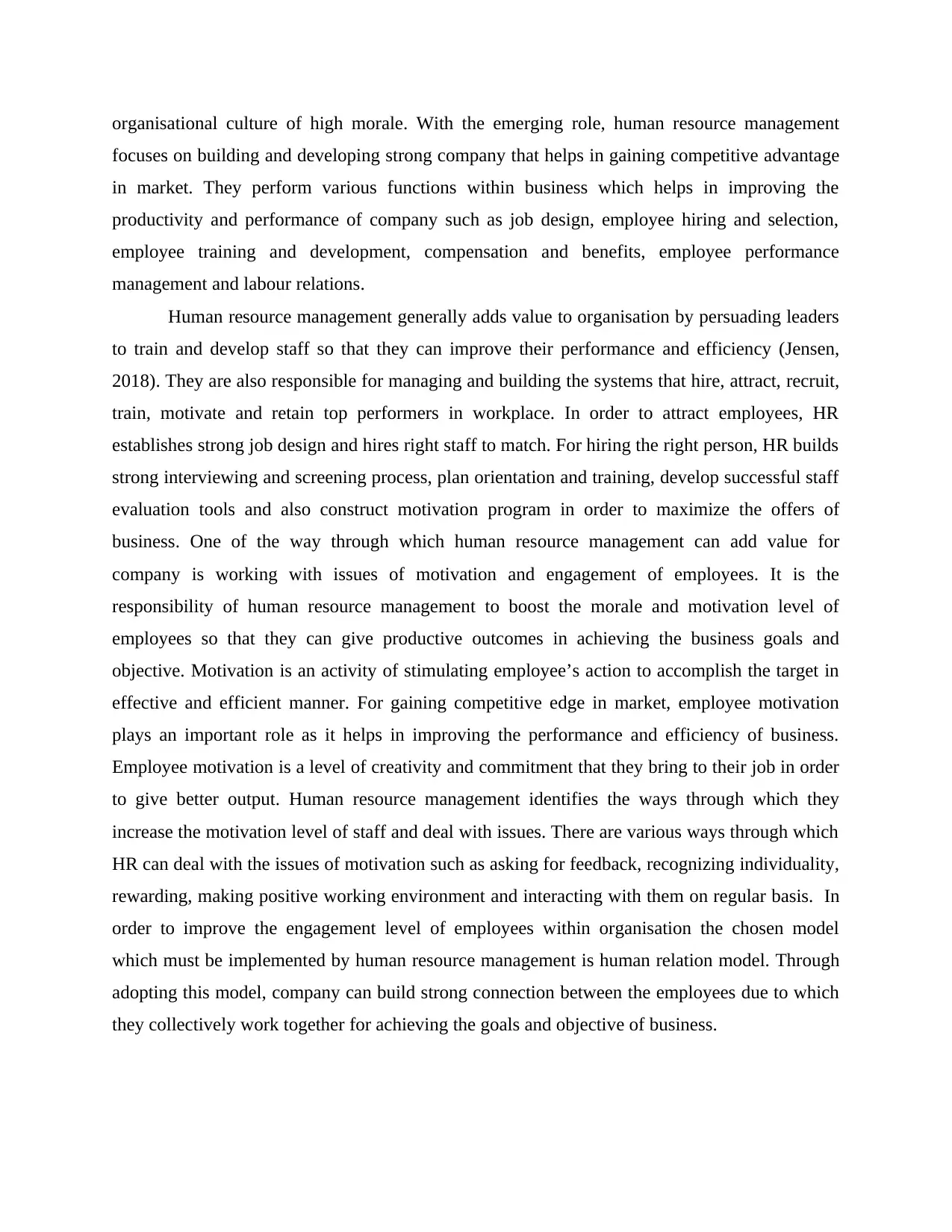
organisational culture of high morale. With the emerging role, human resource management
focuses on building and developing strong company that helps in gaining competitive advantage
in market. They perform various functions within business which helps in improving the
productivity and performance of company such as job design, employee hiring and selection,
employee training and development, compensation and benefits, employee performance
management and labour relations.
Human resource management generally adds value to organisation by persuading leaders
to train and develop staff so that they can improve their performance and efficiency (Jensen,
2018). They are also responsible for managing and building the systems that hire, attract, recruit,
train, motivate and retain top performers in workplace. In order to attract employees, HR
establishes strong job design and hires right staff to match. For hiring the right person, HR builds
strong interviewing and screening process, plan orientation and training, develop successful staff
evaluation tools and also construct motivation program in order to maximize the offers of
business. One of the way through which human resource management can add value for
company is working with issues of motivation and engagement of employees. It is the
responsibility of human resource management to boost the morale and motivation level of
employees so that they can give productive outcomes in achieving the business goals and
objective. Motivation is an activity of stimulating employee’s action to accomplish the target in
effective and efficient manner. For gaining competitive edge in market, employee motivation
plays an important role as it helps in improving the performance and efficiency of business.
Employee motivation is a level of creativity and commitment that they bring to their job in order
to give better output. Human resource management identifies the ways through which they
increase the motivation level of staff and deal with issues. There are various ways through which
HR can deal with the issues of motivation such as asking for feedback, recognizing individuality,
rewarding, making positive working environment and interacting with them on regular basis. In
order to improve the engagement level of employees within organisation the chosen model
which must be implemented by human resource management is human relation model. Through
adopting this model, company can build strong connection between the employees due to which
they collectively work together for achieving the goals and objective of business.
focuses on building and developing strong company that helps in gaining competitive advantage
in market. They perform various functions within business which helps in improving the
productivity and performance of company such as job design, employee hiring and selection,
employee training and development, compensation and benefits, employee performance
management and labour relations.
Human resource management generally adds value to organisation by persuading leaders
to train and develop staff so that they can improve their performance and efficiency (Jensen,
2018). They are also responsible for managing and building the systems that hire, attract, recruit,
train, motivate and retain top performers in workplace. In order to attract employees, HR
establishes strong job design and hires right staff to match. For hiring the right person, HR builds
strong interviewing and screening process, plan orientation and training, develop successful staff
evaluation tools and also construct motivation program in order to maximize the offers of
business. One of the way through which human resource management can add value for
company is working with issues of motivation and engagement of employees. It is the
responsibility of human resource management to boost the morale and motivation level of
employees so that they can give productive outcomes in achieving the business goals and
objective. Motivation is an activity of stimulating employee’s action to accomplish the target in
effective and efficient manner. For gaining competitive edge in market, employee motivation
plays an important role as it helps in improving the performance and efficiency of business.
Employee motivation is a level of creativity and commitment that they bring to their job in order
to give better output. Human resource management identifies the ways through which they
increase the motivation level of staff and deal with issues. There are various ways through which
HR can deal with the issues of motivation such as asking for feedback, recognizing individuality,
rewarding, making positive working environment and interacting with them on regular basis. In
order to improve the engagement level of employees within organisation the chosen model
which must be implemented by human resource management is human relation model. Through
adopting this model, company can build strong connection between the employees due to which
they collectively work together for achieving the goals and objective of business.
Paraphrase This Document
Need a fresh take? Get an instant paraphrase of this document with our AI Paraphraser
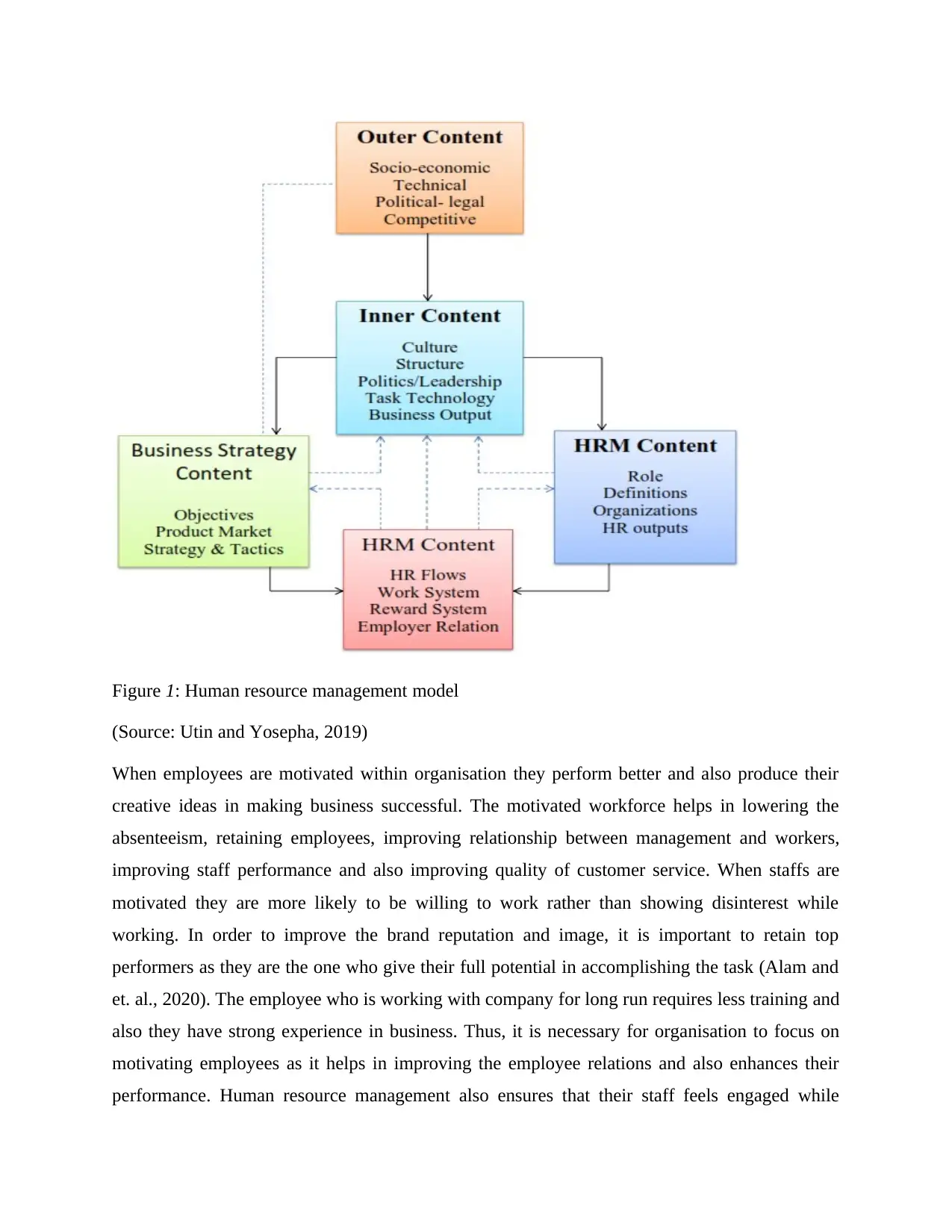
Figure 1: Human resource management model
(Source: Utin and Yosepha, 2019)
When employees are motivated within organisation they perform better and also produce their
creative ideas in making business successful. The motivated workforce helps in lowering the
absenteeism, retaining employees, improving relationship between management and workers,
improving staff performance and also improving quality of customer service. When staffs are
motivated they are more likely to be willing to work rather than showing disinterest while
working. In order to improve the brand reputation and image, it is important to retain top
performers as they are the one who give their full potential in accomplishing the task (Alam and
et. al., 2020). The employee who is working with company for long run requires less training and
also they have strong experience in business. Thus, it is necessary for organisation to focus on
motivating employees as it helps in improving the employee relations and also enhances their
performance. Human resource management also ensures that their staff feels engaged while
(Source: Utin and Yosepha, 2019)
When employees are motivated within organisation they perform better and also produce their
creative ideas in making business successful. The motivated workforce helps in lowering the
absenteeism, retaining employees, improving relationship between management and workers,
improving staff performance and also improving quality of customer service. When staffs are
motivated they are more likely to be willing to work rather than showing disinterest while
working. In order to improve the brand reputation and image, it is important to retain top
performers as they are the one who give their full potential in accomplishing the task (Alam and
et. al., 2020). The employee who is working with company for long run requires less training and
also they have strong experience in business. Thus, it is necessary for organisation to focus on
motivating employees as it helps in improving the employee relations and also enhances their
performance. Human resource management also ensures that their staff feels engaged while
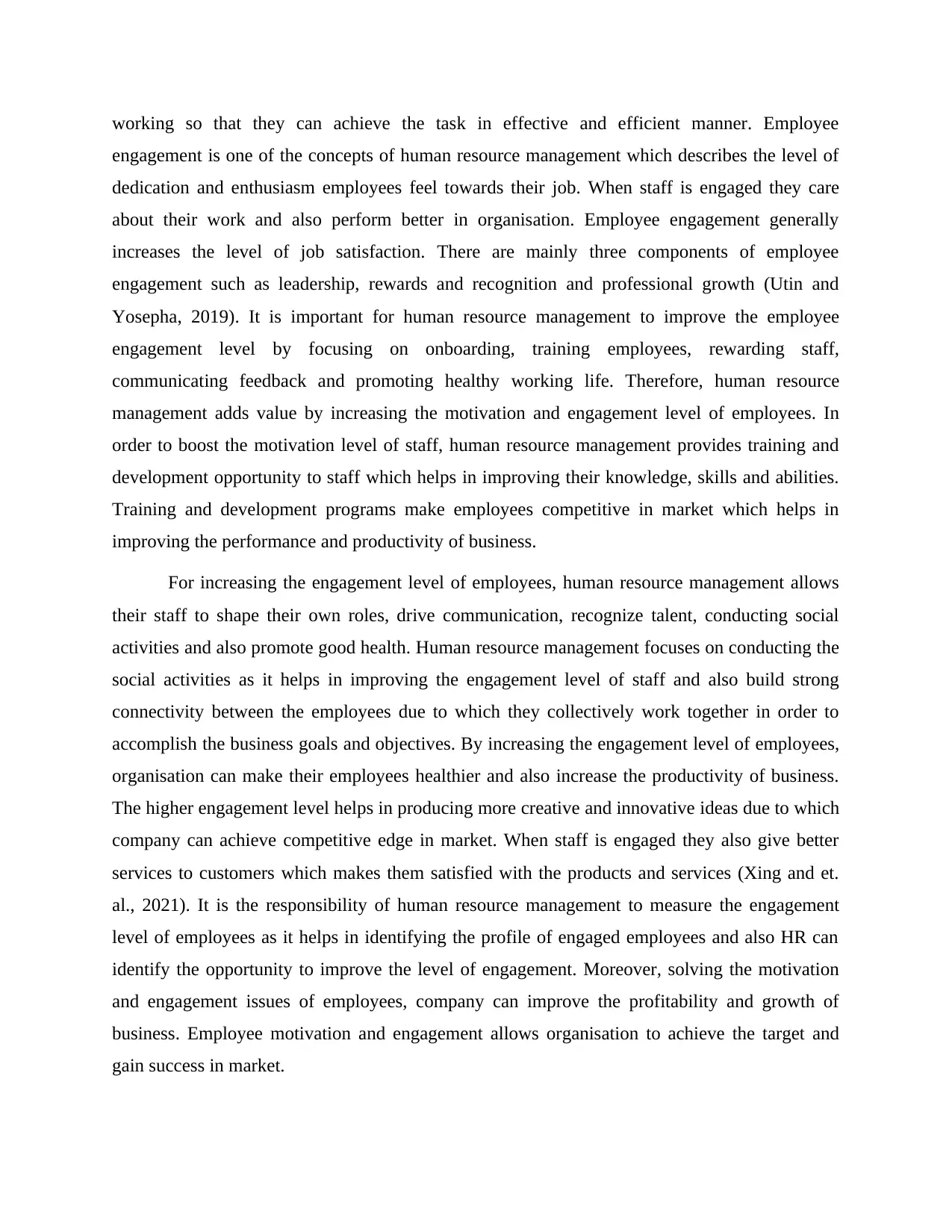
working so that they can achieve the task in effective and efficient manner. Employee
engagement is one of the concepts of human resource management which describes the level of
dedication and enthusiasm employees feel towards their job. When staff is engaged they care
about their work and also perform better in organisation. Employee engagement generally
increases the level of job satisfaction. There are mainly three components of employee
engagement such as leadership, rewards and recognition and professional growth (Utin and
Yosepha, 2019). It is important for human resource management to improve the employee
engagement level by focusing on onboarding, training employees, rewarding staff,
communicating feedback and promoting healthy working life. Therefore, human resource
management adds value by increasing the motivation and engagement level of employees. In
order to boost the motivation level of staff, human resource management provides training and
development opportunity to staff which helps in improving their knowledge, skills and abilities.
Training and development programs make employees competitive in market which helps in
improving the performance and productivity of business.
For increasing the engagement level of employees, human resource management allows
their staff to shape their own roles, drive communication, recognize talent, conducting social
activities and also promote good health. Human resource management focuses on conducting the
social activities as it helps in improving the engagement level of staff and also build strong
connectivity between the employees due to which they collectively work together in order to
accomplish the business goals and objectives. By increasing the engagement level of employees,
organisation can make their employees healthier and also increase the productivity of business.
The higher engagement level helps in producing more creative and innovative ideas due to which
company can achieve competitive edge in market. When staff is engaged they also give better
services to customers which makes them satisfied with the products and services (Xing and et.
al., 2021). It is the responsibility of human resource management to measure the engagement
level of employees as it helps in identifying the profile of engaged employees and also HR can
identify the opportunity to improve the level of engagement. Moreover, solving the motivation
and engagement issues of employees, company can improve the profitability and growth of
business. Employee motivation and engagement allows organisation to achieve the target and
gain success in market.
engagement is one of the concepts of human resource management which describes the level of
dedication and enthusiasm employees feel towards their job. When staff is engaged they care
about their work and also perform better in organisation. Employee engagement generally
increases the level of job satisfaction. There are mainly three components of employee
engagement such as leadership, rewards and recognition and professional growth (Utin and
Yosepha, 2019). It is important for human resource management to improve the employee
engagement level by focusing on onboarding, training employees, rewarding staff,
communicating feedback and promoting healthy working life. Therefore, human resource
management adds value by increasing the motivation and engagement level of employees. In
order to boost the motivation level of staff, human resource management provides training and
development opportunity to staff which helps in improving their knowledge, skills and abilities.
Training and development programs make employees competitive in market which helps in
improving the performance and productivity of business.
For increasing the engagement level of employees, human resource management allows
their staff to shape their own roles, drive communication, recognize talent, conducting social
activities and also promote good health. Human resource management focuses on conducting the
social activities as it helps in improving the engagement level of staff and also build strong
connectivity between the employees due to which they collectively work together in order to
accomplish the business goals and objectives. By increasing the engagement level of employees,
organisation can make their employees healthier and also increase the productivity of business.
The higher engagement level helps in producing more creative and innovative ideas due to which
company can achieve competitive edge in market. When staff is engaged they also give better
services to customers which makes them satisfied with the products and services (Xing and et.
al., 2021). It is the responsibility of human resource management to measure the engagement
level of employees as it helps in identifying the profile of engaged employees and also HR can
identify the opportunity to improve the level of engagement. Moreover, solving the motivation
and engagement issues of employees, company can improve the profitability and growth of
business. Employee motivation and engagement allows organisation to achieve the target and
gain success in market.
⊘ This is a preview!⊘
Do you want full access?
Subscribe today to unlock all pages.

Trusted by 1+ million students worldwide
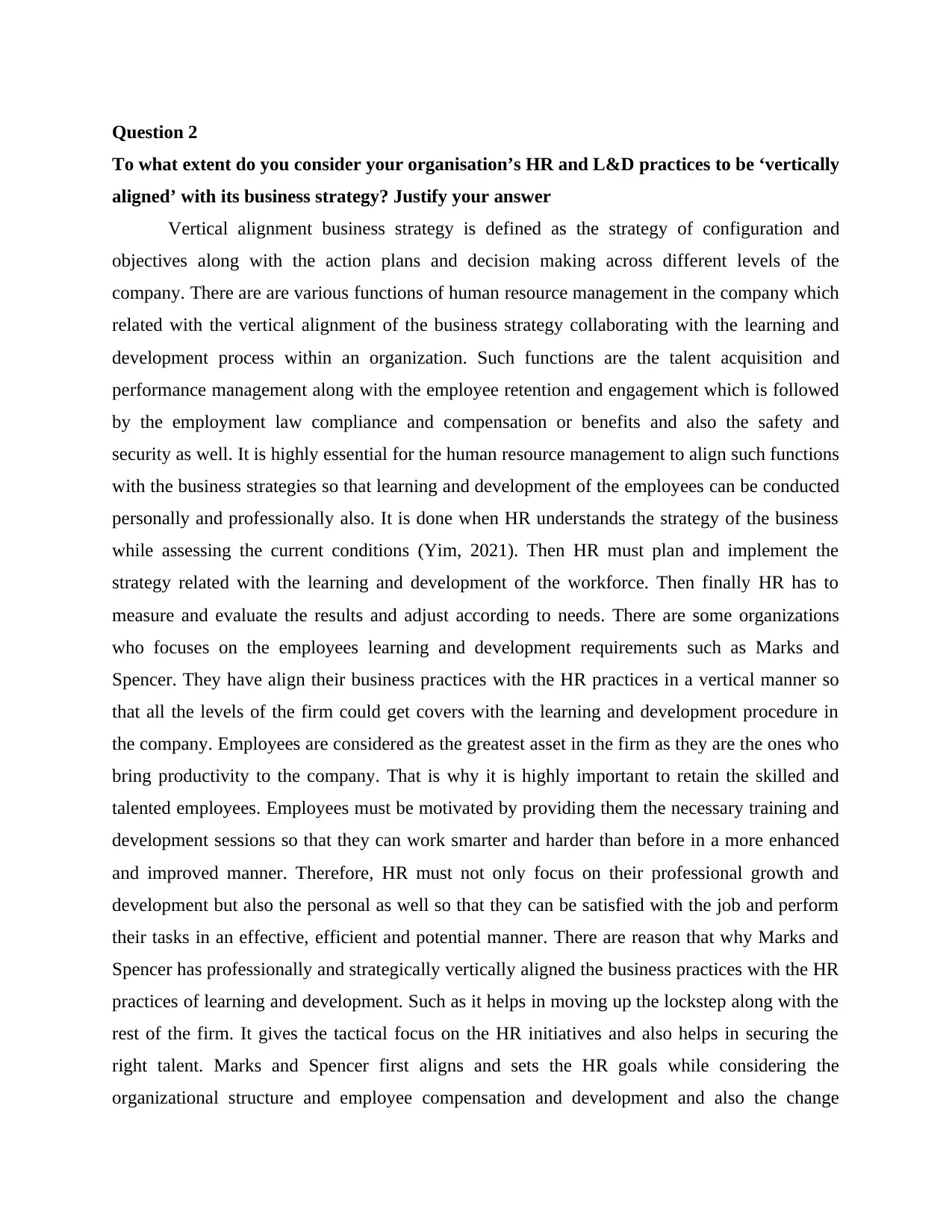
Question 2
To what extent do you consider your organisation’s HR and L&D practices to be ‘vertically
aligned’ with its business strategy? Justify your answer
Vertical alignment business strategy is defined as the strategy of configuration and
objectives along with the action plans and decision making across different levels of the
company. There are are various functions of human resource management in the company which
related with the vertical alignment of the business strategy collaborating with the learning and
development process within an organization. Such functions are the talent acquisition and
performance management along with the employee retention and engagement which is followed
by the employment law compliance and compensation or benefits and also the safety and
security as well. It is highly essential for the human resource management to align such functions
with the business strategies so that learning and development of the employees can be conducted
personally and professionally also. It is done when HR understands the strategy of the business
while assessing the current conditions (Yim, 2021). Then HR must plan and implement the
strategy related with the learning and development of the workforce. Then finally HR has to
measure and evaluate the results and adjust according to needs. There are some organizations
who focuses on the employees learning and development requirements such as Marks and
Spencer. They have align their business practices with the HR practices in a vertical manner so
that all the levels of the firm could get covers with the learning and development procedure in
the company. Employees are considered as the greatest asset in the firm as they are the ones who
bring productivity to the company. That is why it is highly important to retain the skilled and
talented employees. Employees must be motivated by providing them the necessary training and
development sessions so that they can work smarter and harder than before in a more enhanced
and improved manner. Therefore, HR must not only focus on their professional growth and
development but also the personal as well so that they can be satisfied with the job and perform
their tasks in an effective, efficient and potential manner. There are reason that why Marks and
Spencer has professionally and strategically vertically aligned the business practices with the HR
practices of learning and development. Such as it helps in moving up the lockstep along with the
rest of the firm. It gives the tactical focus on the HR initiatives and also helps in securing the
right talent. Marks and Spencer first aligns and sets the HR goals while considering the
organizational structure and employee compensation and development and also the change
To what extent do you consider your organisation’s HR and L&D practices to be ‘vertically
aligned’ with its business strategy? Justify your answer
Vertical alignment business strategy is defined as the strategy of configuration and
objectives along with the action plans and decision making across different levels of the
company. There are are various functions of human resource management in the company which
related with the vertical alignment of the business strategy collaborating with the learning and
development process within an organization. Such functions are the talent acquisition and
performance management along with the employee retention and engagement which is followed
by the employment law compliance and compensation or benefits and also the safety and
security as well. It is highly essential for the human resource management to align such functions
with the business strategies so that learning and development of the employees can be conducted
personally and professionally also. It is done when HR understands the strategy of the business
while assessing the current conditions (Yim, 2021). Then HR must plan and implement the
strategy related with the learning and development of the workforce. Then finally HR has to
measure and evaluate the results and adjust according to needs. There are some organizations
who focuses on the employees learning and development requirements such as Marks and
Spencer. They have align their business practices with the HR practices in a vertical manner so
that all the levels of the firm could get covers with the learning and development procedure in
the company. Employees are considered as the greatest asset in the firm as they are the ones who
bring productivity to the company. That is why it is highly important to retain the skilled and
talented employees. Employees must be motivated by providing them the necessary training and
development sessions so that they can work smarter and harder than before in a more enhanced
and improved manner. Therefore, HR must not only focus on their professional growth and
development but also the personal as well so that they can be satisfied with the job and perform
their tasks in an effective, efficient and potential manner. There are reason that why Marks and
Spencer has professionally and strategically vertically aligned the business practices with the HR
practices of learning and development. Such as it helps in moving up the lockstep along with the
rest of the firm. It gives the tactical focus on the HR initiatives and also helps in securing the
right talent. Marks and Spencer first aligns and sets the HR goals while considering the
organizational structure and employee compensation and development and also the change
Paraphrase This Document
Need a fresh take? Get an instant paraphrase of this document with our AI Paraphraser
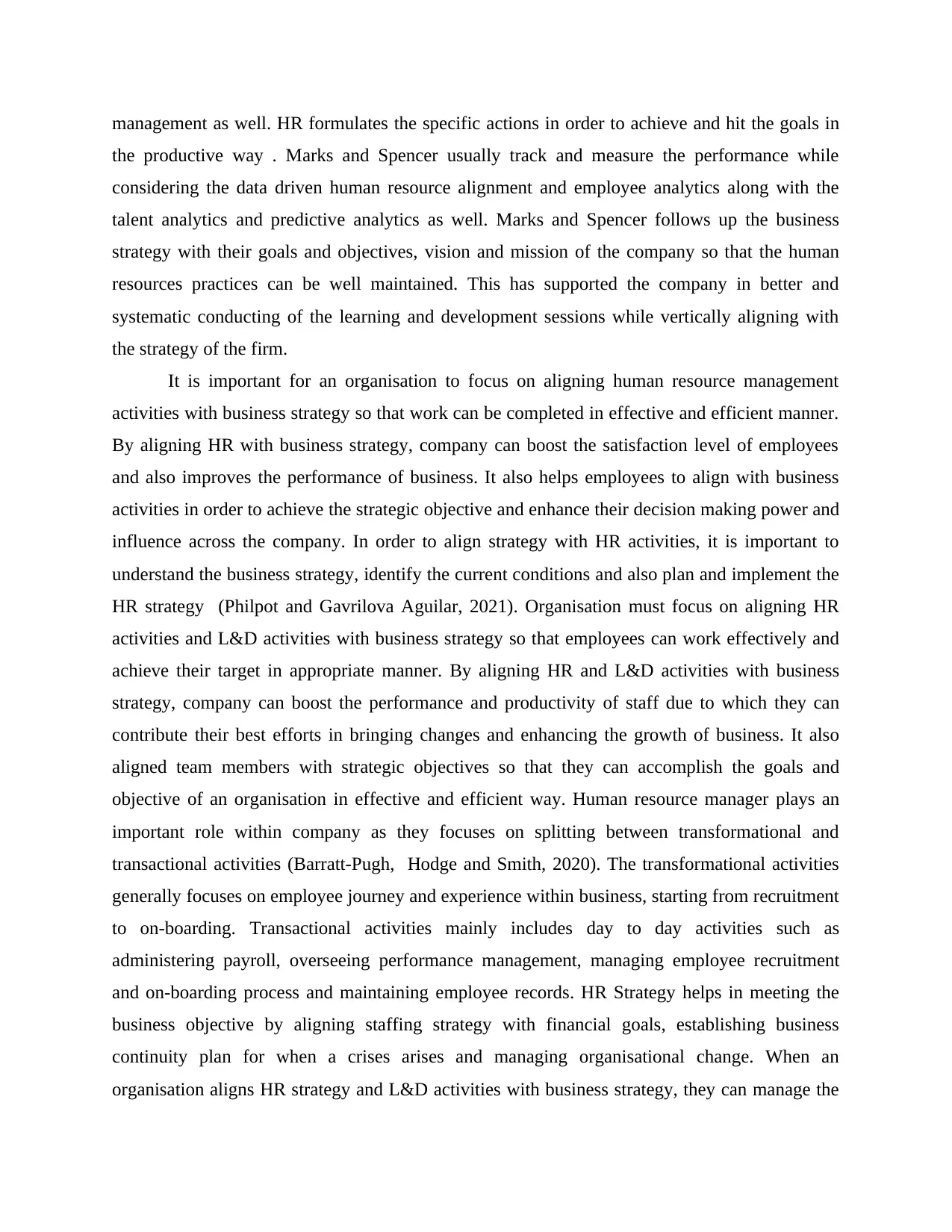
management as well. HR formulates the specific actions in order to achieve and hit the goals in
the productive way . Marks and Spencer usually track and measure the performance while
considering the data driven human resource alignment and employee analytics along with the
talent analytics and predictive analytics as well. Marks and Spencer follows up the business
strategy with their goals and objectives, vision and mission of the company so that the human
resources practices can be well maintained. This has supported the company in better and
systematic conducting of the learning and development sessions while vertically aligning with
the strategy of the firm.
It is important for an organisation to focus on aligning human resource management
activities with business strategy so that work can be completed in effective and efficient manner.
By aligning HR with business strategy, company can boost the satisfaction level of employees
and also improves the performance of business. It also helps employees to align with business
activities in order to achieve the strategic objective and enhance their decision making power and
influence across the company. In order to align strategy with HR activities, it is important to
understand the business strategy, identify the current conditions and also plan and implement the
HR strategy (Philpot and Gavrilova Aguilar, 2021). Organisation must focus on aligning HR
activities and L&D activities with business strategy so that employees can work effectively and
achieve their target in appropriate manner. By aligning HR and L&D activities with business
strategy, company can boost the performance and productivity of staff due to which they can
contribute their best efforts in bringing changes and enhancing the growth of business. It also
aligned team members with strategic objectives so that they can accomplish the goals and
objective of an organisation in effective and efficient way. Human resource manager plays an
important role within company as they focuses on splitting between transformational and
transactional activities (Barratt‐Pugh, Hodge and Smith, 2020). The transformational activities
generally focuses on employee journey and experience within business, starting from recruitment
to on-boarding. Transactional activities mainly includes day to day activities such as
administering payroll, overseeing performance management, managing employee recruitment
and on-boarding process and maintaining employee records. HR Strategy helps in meeting the
business objective by aligning staffing strategy with financial goals, establishing business
continuity plan for when a crises arises and managing organisational change. When an
organisation aligns HR strategy and L&D activities with business strategy, they can manage the
the productive way . Marks and Spencer usually track and measure the performance while
considering the data driven human resource alignment and employee analytics along with the
talent analytics and predictive analytics as well. Marks and Spencer follows up the business
strategy with their goals and objectives, vision and mission of the company so that the human
resources practices can be well maintained. This has supported the company in better and
systematic conducting of the learning and development sessions while vertically aligning with
the strategy of the firm.
It is important for an organisation to focus on aligning human resource management
activities with business strategy so that work can be completed in effective and efficient manner.
By aligning HR with business strategy, company can boost the satisfaction level of employees
and also improves the performance of business. It also helps employees to align with business
activities in order to achieve the strategic objective and enhance their decision making power and
influence across the company. In order to align strategy with HR activities, it is important to
understand the business strategy, identify the current conditions and also plan and implement the
HR strategy (Philpot and Gavrilova Aguilar, 2021). Organisation must focus on aligning HR
activities and L&D activities with business strategy so that employees can work effectively and
achieve their target in appropriate manner. By aligning HR and L&D activities with business
strategy, company can boost the performance and productivity of staff due to which they can
contribute their best efforts in bringing changes and enhancing the growth of business. It also
aligned team members with strategic objectives so that they can accomplish the goals and
objective of an organisation in effective and efficient way. Human resource manager plays an
important role within company as they focuses on splitting between transformational and
transactional activities (Barratt‐Pugh, Hodge and Smith, 2020). The transformational activities
generally focuses on employee journey and experience within business, starting from recruitment
to on-boarding. Transactional activities mainly includes day to day activities such as
administering payroll, overseeing performance management, managing employee recruitment
and on-boarding process and maintaining employee records. HR Strategy helps in meeting the
business objective by aligning staffing strategy with financial goals, establishing business
continuity plan for when a crises arises and managing organisational change. When an
organisation aligns HR strategy and L&D activities with business strategy, they can manage the
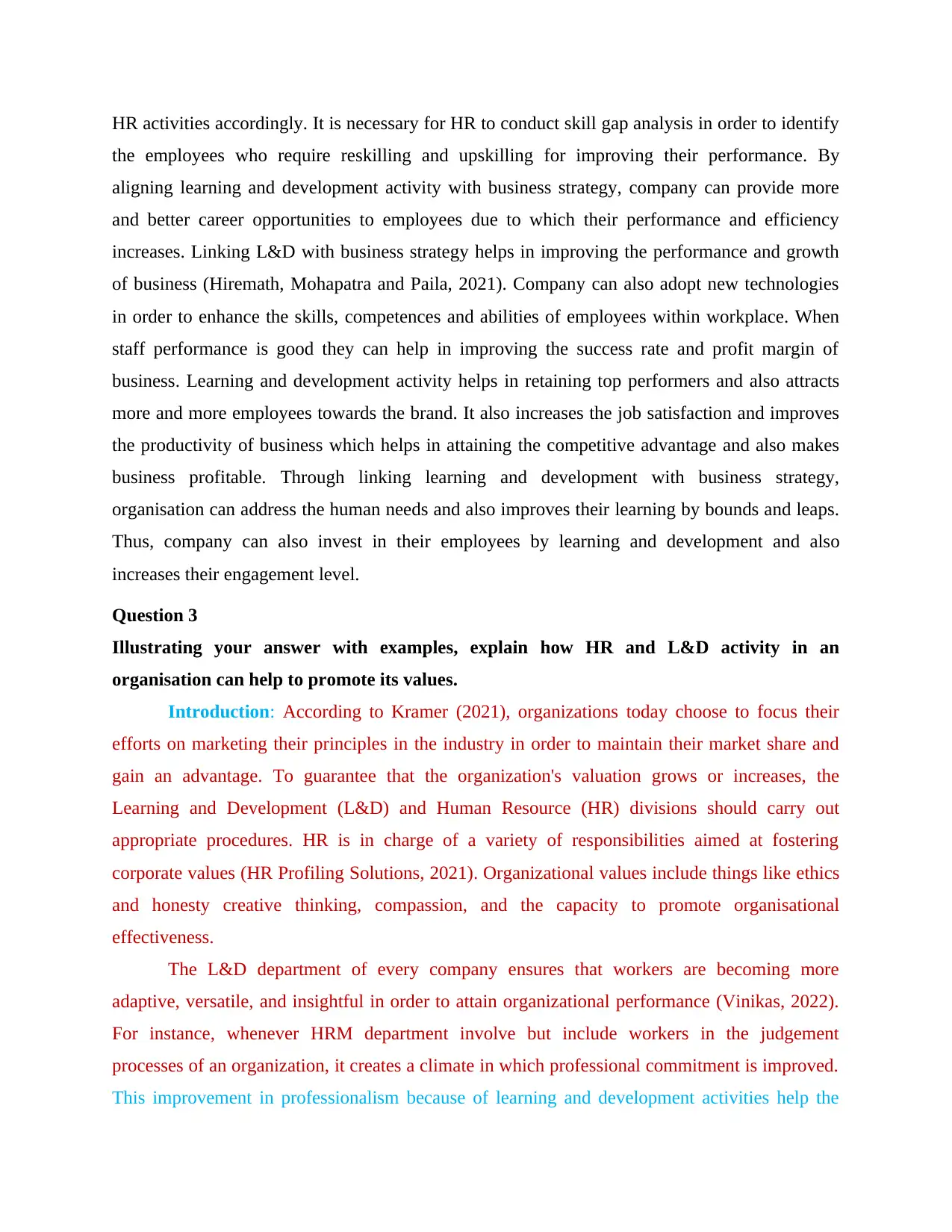
HR activities accordingly. It is necessary for HR to conduct skill gap analysis in order to identify
the employees who require reskilling and upskilling for improving their performance. By
aligning learning and development activity with business strategy, company can provide more
and better career opportunities to employees due to which their performance and efficiency
increases. Linking L&D with business strategy helps in improving the performance and growth
of business (Hiremath, Mohapatra and Paila, 2021). Company can also adopt new technologies
in order to enhance the skills, competences and abilities of employees within workplace. When
staff performance is good they can help in improving the success rate and profit margin of
business. Learning and development activity helps in retaining top performers and also attracts
more and more employees towards the brand. It also increases the job satisfaction and improves
the productivity of business which helps in attaining the competitive advantage and also makes
business profitable. Through linking learning and development with business strategy,
organisation can address the human needs and also improves their learning by bounds and leaps.
Thus, company can also invest in their employees by learning and development and also
increases their engagement level.
Question 3
Illustrating your answer with examples, explain how HR and L&D activity in an
organisation can help to promote its values.
Introduction: According to Kramer (2021), organizations today choose to focus their
efforts on marketing their principles in the industry in order to maintain their market share and
gain an advantage. To guarantee that the organization's valuation grows or increases, the
Learning and Development (L&D) and Human Resource (HR) divisions should carry out
appropriate procedures. HR is in charge of a variety of responsibilities aimed at fostering
corporate values (HR Profiling Solutions, 2021). Organizational values include things like ethics
and honesty creative thinking, compassion, and the capacity to promote organisational
effectiveness.
The L&D department of every company ensures that workers are becoming more
adaptive, versatile, and insightful in order to attain organizational performance (Vinikas, 2022).
For instance, whenever HRM department involve but include workers in the judgement
processes of an organization, it creates a climate in which professional commitment is improved.
This improvement in professionalism because of learning and development activities help the
the employees who require reskilling and upskilling for improving their performance. By
aligning learning and development activity with business strategy, company can provide more
and better career opportunities to employees due to which their performance and efficiency
increases. Linking L&D with business strategy helps in improving the performance and growth
of business (Hiremath, Mohapatra and Paila, 2021). Company can also adopt new technologies
in order to enhance the skills, competences and abilities of employees within workplace. When
staff performance is good they can help in improving the success rate and profit margin of
business. Learning and development activity helps in retaining top performers and also attracts
more and more employees towards the brand. It also increases the job satisfaction and improves
the productivity of business which helps in attaining the competitive advantage and also makes
business profitable. Through linking learning and development with business strategy,
organisation can address the human needs and also improves their learning by bounds and leaps.
Thus, company can also invest in their employees by learning and development and also
increases their engagement level.
Question 3
Illustrating your answer with examples, explain how HR and L&D activity in an
organisation can help to promote its values.
Introduction: According to Kramer (2021), organizations today choose to focus their
efforts on marketing their principles in the industry in order to maintain their market share and
gain an advantage. To guarantee that the organization's valuation grows or increases, the
Learning and Development (L&D) and Human Resource (HR) divisions should carry out
appropriate procedures. HR is in charge of a variety of responsibilities aimed at fostering
corporate values (HR Profiling Solutions, 2021). Organizational values include things like ethics
and honesty creative thinking, compassion, and the capacity to promote organisational
effectiveness.
The L&D department of every company ensures that workers are becoming more
adaptive, versatile, and insightful in order to attain organizational performance (Vinikas, 2022).
For instance, whenever HRM department involve but include workers in the judgement
processes of an organization, it creates a climate in which professional commitment is improved.
This improvement in professionalism because of learning and development activities help the
⊘ This is a preview!⊘
Do you want full access?
Subscribe today to unlock all pages.

Trusted by 1+ million students worldwide
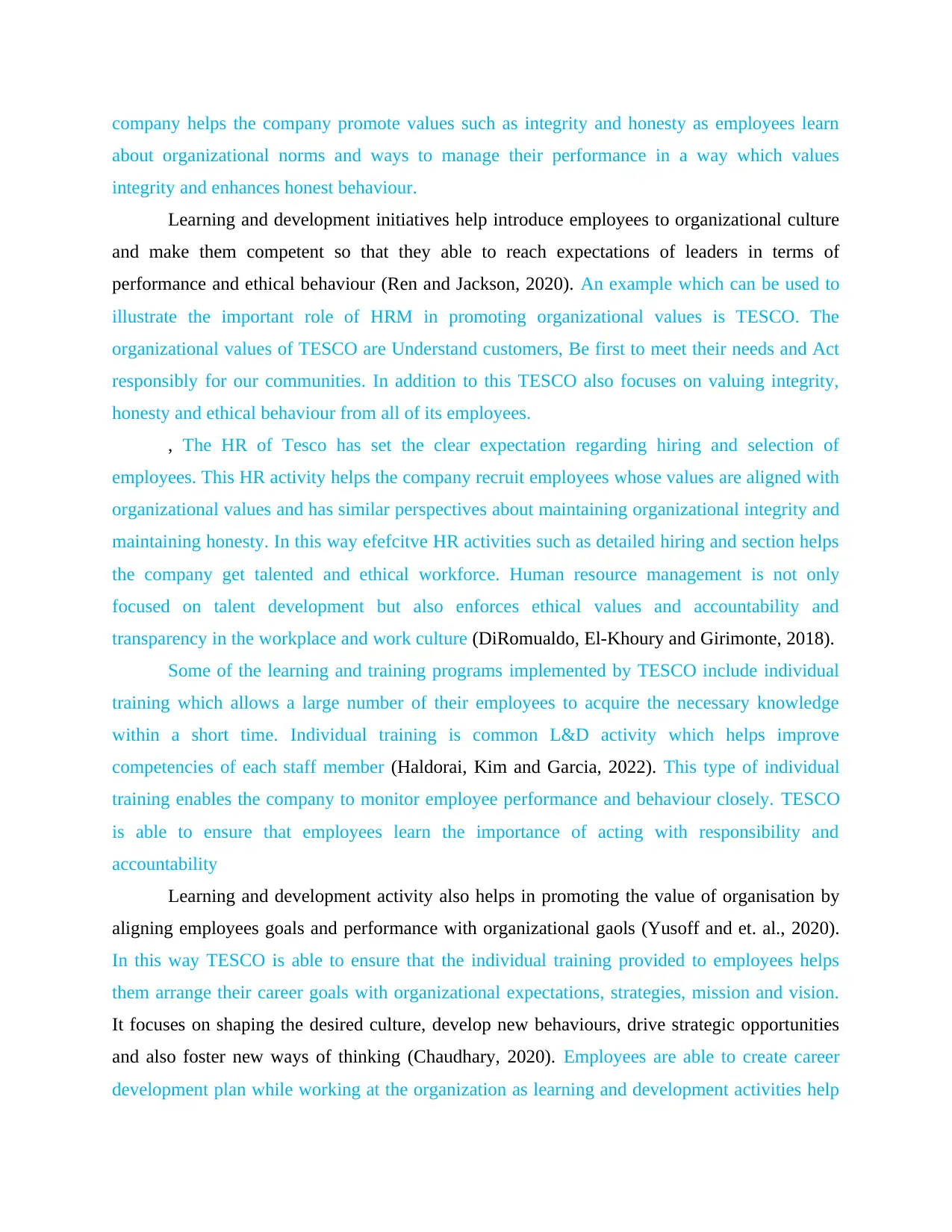
company helps the company promote values such as integrity and honesty as employees learn
about organizational norms and ways to manage their performance in a way which values
integrity and enhances honest behaviour.
Learning and development initiatives help introduce employees to organizational culture
and make them competent so that they able to reach expectations of leaders in terms of
performance and ethical behaviour (Ren and Jackson, 2020). An example which can be used to
illustrate the important role of HRM in promoting organizational values is TESCO. The
organizational values of TESCO are Understand customers, Be first to meet their needs and Act
responsibly for our communities. In addition to this TESCO also focuses on valuing integrity,
honesty and ethical behaviour from all of its employees.
, The HR of Tesco has set the clear expectation regarding hiring and selection of
employees. This HR activity helps the company recruit employees whose values are aligned with
organizational values and has similar perspectives about maintaining organizational integrity and
maintaining honesty. In this way efefcitve HR activities such as detailed hiring and section helps
the company get talented and ethical workforce. Human resource management is not only
focused on talent development but also enforces ethical values and accountability and
transparency in the workplace and work culture (DiRomualdo, El-Khoury and Girimonte, 2018).
Some of the learning and training programs implemented by TESCO include individual
training which allows a large number of their employees to acquire the necessary knowledge
within a short time. Individual training is common L&D activity which helps improve
competencies of each staff member (Haldorai, Kim and Garcia, 2022). This type of individual
training enables the company to monitor employee performance and behaviour closely. TESCO
is able to ensure that employees learn the importance of acting with responsibility and
accountability
Learning and development activity also helps in promoting the value of organisation by
aligning employees goals and performance with organizational gaols (Yusoff and et. al., 2020).
In this way TESCO is able to ensure that the individual training provided to employees helps
them arrange their career goals with organizational expectations, strategies, mission and vision.
It focuses on shaping the desired culture, develop new behaviours, drive strategic opportunities
and also foster new ways of thinking (Chaudhary, 2020). Employees are able to create career
development plan while working at the organization as learning and development activities help
about organizational norms and ways to manage their performance in a way which values
integrity and enhances honest behaviour.
Learning and development initiatives help introduce employees to organizational culture
and make them competent so that they able to reach expectations of leaders in terms of
performance and ethical behaviour (Ren and Jackson, 2020). An example which can be used to
illustrate the important role of HRM in promoting organizational values is TESCO. The
organizational values of TESCO are Understand customers, Be first to meet their needs and Act
responsibly for our communities. In addition to this TESCO also focuses on valuing integrity,
honesty and ethical behaviour from all of its employees.
, The HR of Tesco has set the clear expectation regarding hiring and selection of
employees. This HR activity helps the company recruit employees whose values are aligned with
organizational values and has similar perspectives about maintaining organizational integrity and
maintaining honesty. In this way efefcitve HR activities such as detailed hiring and section helps
the company get talented and ethical workforce. Human resource management is not only
focused on talent development but also enforces ethical values and accountability and
transparency in the workplace and work culture (DiRomualdo, El-Khoury and Girimonte, 2018).
Some of the learning and training programs implemented by TESCO include individual
training which allows a large number of their employees to acquire the necessary knowledge
within a short time. Individual training is common L&D activity which helps improve
competencies of each staff member (Haldorai, Kim and Garcia, 2022). This type of individual
training enables the company to monitor employee performance and behaviour closely. TESCO
is able to ensure that employees learn the importance of acting with responsibility and
accountability
Learning and development activity also helps in promoting the value of organisation by
aligning employees goals and performance with organizational gaols (Yusoff and et. al., 2020).
In this way TESCO is able to ensure that the individual training provided to employees helps
them arrange their career goals with organizational expectations, strategies, mission and vision.
It focuses on shaping the desired culture, develop new behaviours, drive strategic opportunities
and also foster new ways of thinking (Chaudhary, 2020). Employees are able to create career
development plan while working at the organization as learning and development activities help
Paraphrase This Document
Need a fresh take? Get an instant paraphrase of this document with our AI Paraphraser
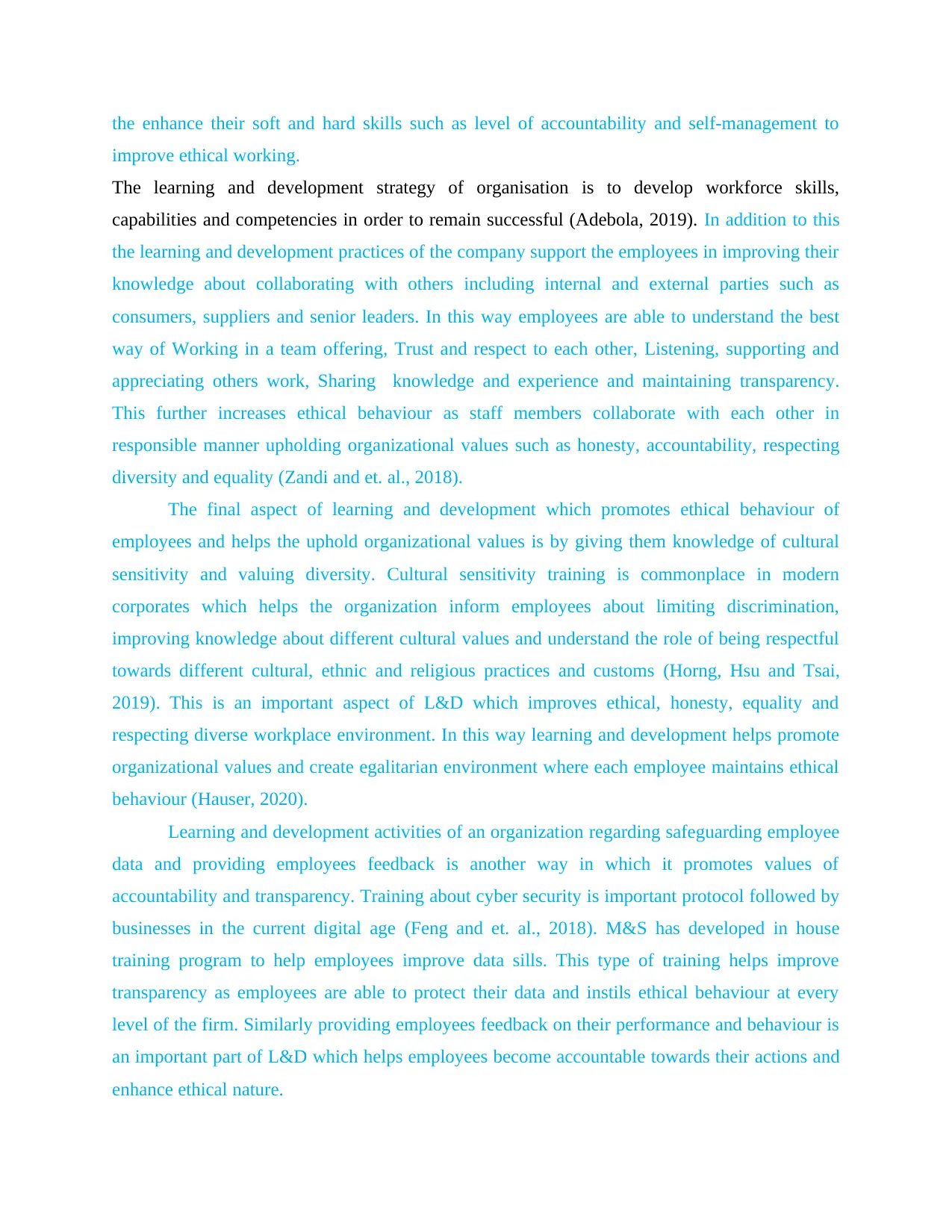
the enhance their soft and hard skills such as level of accountability and self-management to
improve ethical working.
The learning and development strategy of organisation is to develop workforce skills,
capabilities and competencies in order to remain successful (Adebola, 2019). In addition to this
the learning and development practices of the company support the employees in improving their
knowledge about collaborating with others including internal and external parties such as
consumers, suppliers and senior leaders. In this way employees are able to understand the best
way of Working in a team offering, Trust and respect to each other, Listening, supporting and
appreciating others work, Sharing knowledge and experience and maintaining transparency.
This further increases ethical behaviour as staff members collaborate with each other in
responsible manner upholding organizational values such as honesty, accountability, respecting
diversity and equality (Zandi and et. al., 2018).
The final aspect of learning and development which promotes ethical behaviour of
employees and helps the uphold organizational values is by giving them knowledge of cultural
sensitivity and valuing diversity. Cultural sensitivity training is commonplace in modern
corporates which helps the organization inform employees about limiting discrimination,
improving knowledge about different cultural values and understand the role of being respectful
towards different cultural, ethnic and religious practices and customs (Horng, Hsu and Tsai,
2019). This is an important aspect of L&D which improves ethical, honesty, equality and
respecting diverse workplace environment. In this way learning and development helps promote
organizational values and create egalitarian environment where each employee maintains ethical
behaviour (Hauser, 2020).
Learning and development activities of an organization regarding safeguarding employee
data and providing employees feedback is another way in which it promotes values of
accountability and transparency. Training about cyber security is important protocol followed by
businesses in the current digital age (Feng and et. al., 2018). M&S has developed in house
training program to help employees improve data sills. This type of training helps improve
transparency as employees are able to protect their data and instils ethical behaviour at every
level of the firm. Similarly providing employees feedback on their performance and behaviour is
an important part of L&D which helps employees become accountable towards their actions and
enhance ethical nature.
improve ethical working.
The learning and development strategy of organisation is to develop workforce skills,
capabilities and competencies in order to remain successful (Adebola, 2019). In addition to this
the learning and development practices of the company support the employees in improving their
knowledge about collaborating with others including internal and external parties such as
consumers, suppliers and senior leaders. In this way employees are able to understand the best
way of Working in a team offering, Trust and respect to each other, Listening, supporting and
appreciating others work, Sharing knowledge and experience and maintaining transparency.
This further increases ethical behaviour as staff members collaborate with each other in
responsible manner upholding organizational values such as honesty, accountability, respecting
diversity and equality (Zandi and et. al., 2018).
The final aspect of learning and development which promotes ethical behaviour of
employees and helps the uphold organizational values is by giving them knowledge of cultural
sensitivity and valuing diversity. Cultural sensitivity training is commonplace in modern
corporates which helps the organization inform employees about limiting discrimination,
improving knowledge about different cultural values and understand the role of being respectful
towards different cultural, ethnic and religious practices and customs (Horng, Hsu and Tsai,
2019). This is an important aspect of L&D which improves ethical, honesty, equality and
respecting diverse workplace environment. In this way learning and development helps promote
organizational values and create egalitarian environment where each employee maintains ethical
behaviour (Hauser, 2020).
Learning and development activities of an organization regarding safeguarding employee
data and providing employees feedback is another way in which it promotes values of
accountability and transparency. Training about cyber security is important protocol followed by
businesses in the current digital age (Feng and et. al., 2018). M&S has developed in house
training program to help employees improve data sills. This type of training helps improve
transparency as employees are able to protect their data and instils ethical behaviour at every
level of the firm. Similarly providing employees feedback on their performance and behaviour is
an important part of L&D which helps employees become accountable towards their actions and
enhance ethical nature.
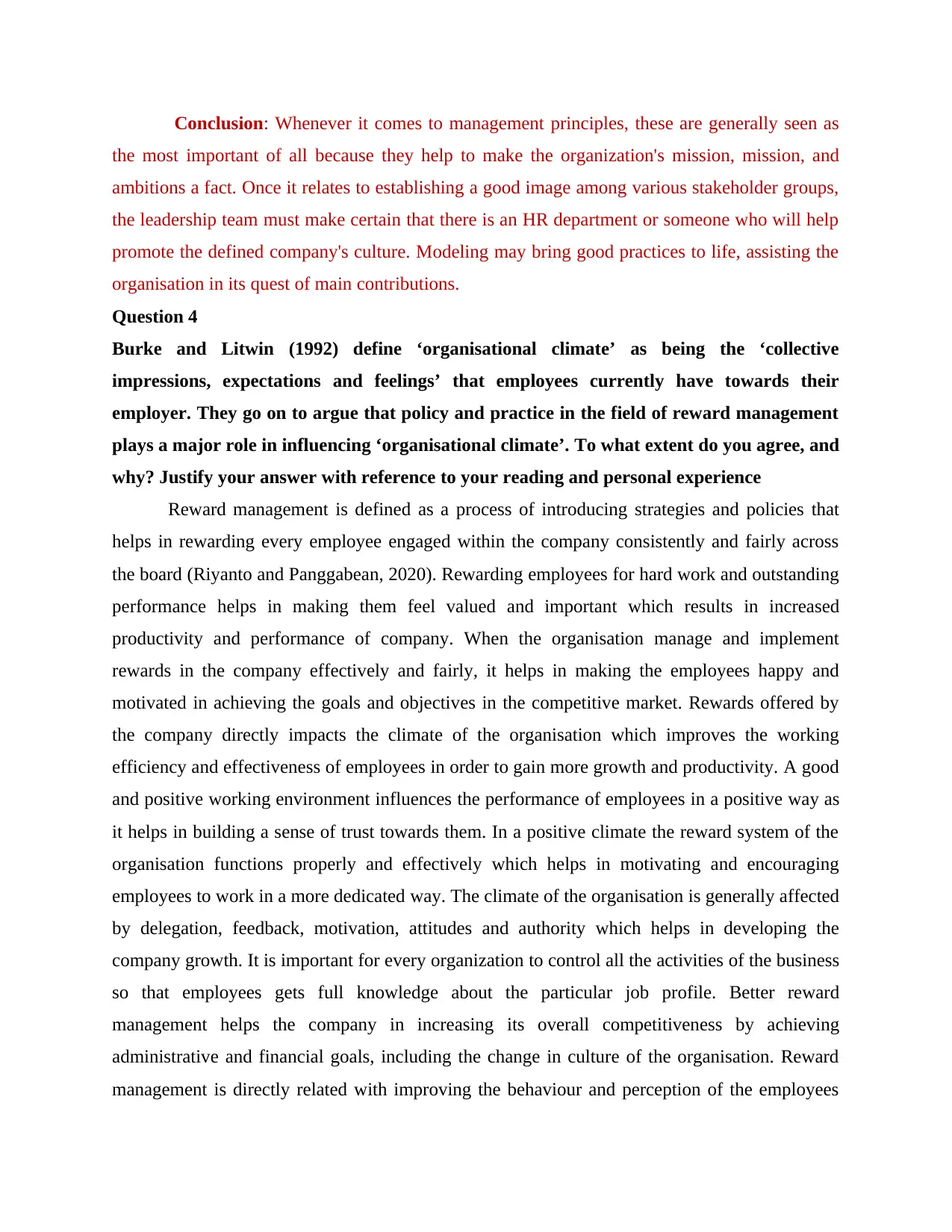
Conclusion: Whenever it comes to management principles, these are generally seen as
the most important of all because they help to make the organization's mission, mission, and
ambitions a fact. Once it relates to establishing a good image among various stakeholder groups,
the leadership team must make certain that there is an HR department or someone who will help
promote the defined company's culture. Modeling may bring good practices to life, assisting the
organisation in its quest of main contributions.
Question 4
Burke and Litwin (1992) define ‘organisational climate’ as being the ‘collective
impressions, expectations and feelings’ that employees currently have towards their
employer. They go on to argue that policy and practice in the field of reward management
plays a major role in influencing ‘organisational climate’. To what extent do you agree, and
why? Justify your answer with reference to your reading and personal experience
Reward management is defined as a process of introducing strategies and policies that
helps in rewarding every employee engaged within the company consistently and fairly across
the board (Riyanto and Panggabean, 2020). Rewarding employees for hard work and outstanding
performance helps in making them feel valued and important which results in increased
productivity and performance of company. When the organisation manage and implement
rewards in the company effectively and fairly, it helps in making the employees happy and
motivated in achieving the goals and objectives in the competitive market. Rewards offered by
the company directly impacts the climate of the organisation which improves the working
efficiency and effectiveness of employees in order to gain more growth and productivity. A good
and positive working environment influences the performance of employees in a positive way as
it helps in building a sense of trust towards them. In a positive climate the reward system of the
organisation functions properly and effectively which helps in motivating and encouraging
employees to work in a more dedicated way. The climate of the organisation is generally affected
by delegation, feedback, motivation, attitudes and authority which helps in developing the
company growth. It is important for every organization to control all the activities of the business
so that employees gets full knowledge about the particular job profile. Better reward
management helps the company in increasing its overall competitiveness by achieving
administrative and financial goals, including the change in culture of the organisation. Reward
management is directly related with improving the behaviour and perception of the employees
the most important of all because they help to make the organization's mission, mission, and
ambitions a fact. Once it relates to establishing a good image among various stakeholder groups,
the leadership team must make certain that there is an HR department or someone who will help
promote the defined company's culture. Modeling may bring good practices to life, assisting the
organisation in its quest of main contributions.
Question 4
Burke and Litwin (1992) define ‘organisational climate’ as being the ‘collective
impressions, expectations and feelings’ that employees currently have towards their
employer. They go on to argue that policy and practice in the field of reward management
plays a major role in influencing ‘organisational climate’. To what extent do you agree, and
why? Justify your answer with reference to your reading and personal experience
Reward management is defined as a process of introducing strategies and policies that
helps in rewarding every employee engaged within the company consistently and fairly across
the board (Riyanto and Panggabean, 2020). Rewarding employees for hard work and outstanding
performance helps in making them feel valued and important which results in increased
productivity and performance of company. When the organisation manage and implement
rewards in the company effectively and fairly, it helps in making the employees happy and
motivated in achieving the goals and objectives in the competitive market. Rewards offered by
the company directly impacts the climate of the organisation which improves the working
efficiency and effectiveness of employees in order to gain more growth and productivity. A good
and positive working environment influences the performance of employees in a positive way as
it helps in building a sense of trust towards them. In a positive climate the reward system of the
organisation functions properly and effectively which helps in motivating and encouraging
employees to work in a more dedicated way. The climate of the organisation is generally affected
by delegation, feedback, motivation, attitudes and authority which helps in developing the
company growth. It is important for every organization to control all the activities of the business
so that employees gets full knowledge about the particular job profile. Better reward
management helps the company in increasing its overall competitiveness by achieving
administrative and financial goals, including the change in culture of the organisation. Reward
management is directly related with improving the behaviour and perception of the employees
⊘ This is a preview!⊘
Do you want full access?
Subscribe today to unlock all pages.

Trusted by 1+ million students worldwide
1 out of 56
Related Documents
Your All-in-One AI-Powered Toolkit for Academic Success.
+13062052269
info@desklib.com
Available 24*7 on WhatsApp / Email
![[object Object]](/_next/static/media/star-bottom.7253800d.svg)
Unlock your academic potential
Copyright © 2020–2025 A2Z Services. All Rights Reserved. Developed and managed by ZUCOL.




